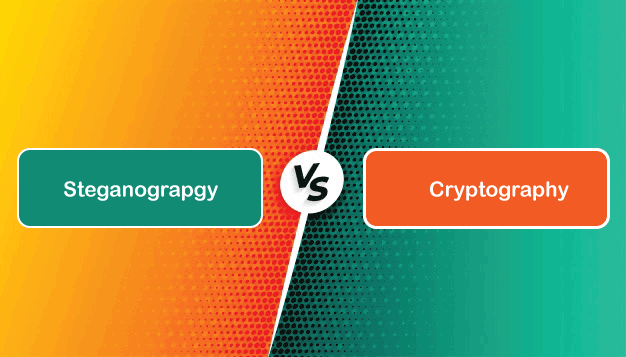Difference between Steganography and CryptographySteganography and cryptography are important parts of network security. Network security has evolved into an essential component of today's communication infrastructure. There was an urgent need for network security to protect confidentiality and data integrity. It protects the user from unauthorized access. Steganography conceals the communication traces, whereas cryptography utilizes encryption to render the message incomprehensible. In this article, you will learn about the difference between Steganography and Cryptography. But before discussing the differences, you must know about Steganography and Cryptography. What is Steganography?Steganography is a method of hiding information by hiding the secret message within a fake message. The term steganography contains Greek influences, which mean "covered writing". The primary goal of steganography is to prevent suspicion regarding the existence of data. In the past, the message was concealed using invisible ink, pencil marks on the handwritten characters, and tiny pin punctures. The simplest method of hiding a message is to compose a message that contains the hidden message just within a select few important characters. The steganography technique contains a cover carrier, stego key, secret message, and stego carrier. Text, image, voice, and video are cover carriers for the secret information, and Stego carrier is produced by utilizing a cover carrier and an embedded message. The Stego key may also be utilized as additional secret information, such as a password utilized by the receiver to extract the message. Forms of SteganographyThere are various forms of steganography. Some of the forms are as follows: 1. Audio Steganography It helps to encode a secret message into an audio signal, which alters the binary sequence of the associated audio file. The process of hiding a secret message in the digital sound is more complex than other steganography. 2. Image Steganography The process of concealing information by using the cover object as the image is known as image steganography. It's a frequent cover source in digital steganography, as an image's digital representation has many bits. There are numerous methods for concealing information within an image. These methods are as follows:
3. Video Steganography Video steganography offers greater opportunities for masking a lot of data because it is a combination of combines sound and image. As a result, the video may also use image and audio steganography techniques. 4. Text Steganography It contains concealing data within text files. This approach hides the secret data behind each nth letter of every text message word. There are numerous methods for hiding information in a text file. 5. Network or Protocol Steganography It consists of concealing information by using network protocols such as TCP, UDP, ICMP, and IP as cover objects. There are covert channels in the OSI layer network model that can be used with steganography. What is Cryptography?Cryptography is a method for securing data and communications by employing codes that only the persons who require the information can understand and process. As a result, it aids in preventing unwanted access to information. The word cryptography means "Secret or hidden writing". Cryptography techniques are developed from mathematical concepts and a set of rule-based computations known as algorithms to modify communications in ways that make them complex to decode. These algorithms are utilized to generate cryptographic keys, verify data privacy, digitally sign documents, and protect confidential transactions like credit card and debit card transactions. Types of CryptographyThere are mainly three types of cryptography. These are as follows: 1. Symmetric Key Cryptography It employs a key to encrypt and decrypt plain text and cipher text, and it uses the same key for encryption and decryption and takes less time to execute. 2. Asymmetric key cryptography The public key cryptography technique employs two keys: a private key and a public key. The receiver provides the public key to the sender to encrypt the message. On the other hand, the receiver utilizes the private key to decrypt the message. The keys are reusable for other entities. 3. Hash Functions A hash function is another kind of cryptography system. It utilizes the random input values and produces a fixed output value that may be utilized to recognize the user and recover confidential data. Many OS utilizes these functions to encrypt passwords. Features of Cryptography SystemThere are various features of the Cryptography system. Some features of them are as follows: 1. Authentication Before exchanging any information, identify and then authorize both the sender and the receiver. 2. Confidentiality Information may only be accessed by the user for whom it was planned, and no other user except him may access it. 3. Non-repudiation The information's author or sender cannot retract his desire to send additional information. 4. Integrity Information may not be changed in storage or during the transfer between the sender and the intended receiver without any modification to the information being detected. Key Differences between Steganography and Cryptography
There are various key differences between Steganography and Cryptography. Some main key differences between Steganography and Cryptography are as follows:
Head-to-head comparison between Steganography and CryptographyHere, you will learn the head-to-head comparisons between Steganography and Cryptography. The main differences between Steganography and Cryptography are as follows:
ConclusionSteganography is the science that deals with how communication may be disguised, whereas cryptography is the science that deals with altering communication content and making it hidden. The most significant distinction between steganography and cryptography is that the data structure remains constant with steganography, whereas it is not the case in cryptography. Steganography does not require many mathematical transformations, whereas cryptography alters data using number theory, mathematics, and other approaches.
Next TopicDifference between
|
 For Videos Join Our Youtube Channel: Join Now
For Videos Join Our Youtube Channel: Join Now
Feedback
- Send your Feedback to [email protected]
Help Others, Please Share










